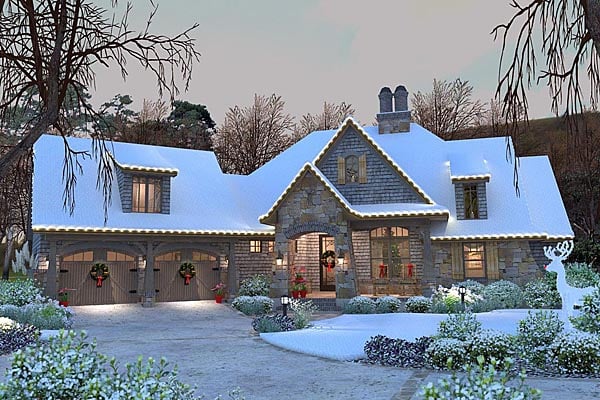How to Calculate the Total Heated Square Footage of a House Plan
A house plan’s total square footage tells you how many square feet of finished space a plan offers. The finished space is the heated living area of the house. Finished space usually has floor coverings such as wood, vinyl, ceramic, carpeting, or tile.
Unfinished square footage such as garages, porches, decks, attics, bonus rooms, courtyards, and driveways are typically not included as part of a plan’s total heated living space. A basement is not included in the finished total square footage unless the basement is finished. A 3-season porch is not considered finished square footage because it is not heated and cooled space.
Total heated square footage is not the same as the total heated floor space. Typically the total heated square footage is calculated using the dimensions starting from the outside studs of the home’s exterior. The heated square footage doesn’t include exterior wall coverings such as brick, stucco, or siding. The square footage does include space that is taken up by walls.
Cantilevered floor sections also affect the total heated square footage. A cantilevered room such as a bay window is counted as finished square footage if the floor joists are part of the cantilever. If a cantilevered space does not include floor space, then the cantilevered area is not counted as part of the square footage. If a fireplace cantilevers, then the cantilever’s square footage is counted as finished square footage on the floor that has the fireplace but not on other floors.
For stairways in a two-story home plan, usually, the staircase space is counted once when calculating total square footages. However, a few house designers or homebuilders consider a stairway transitional space and sometimes count it as square footage on both floors (call 800-482-0464 to verify if the home plan you are interested in is calculated this way).
If you compare two home plans with the “same” total finished square footage, you may want to remember that the wall space is part of the square footage. For example, if you see a one-story house with the same finished square footage as a two-story house, then the one-story house will have more interior space. This is because the two-story house has another floor of exterior walls considered part of its total square footage. Also, a two-story house needs more space for hallways and stairways, and the useable square footage of a two-story house is usually less when compared to a one-story house with the same total square footage.
Square footage is needed for the marketing of new single-family dwellings.
The competition among residential homebuilders is very keen. In their interest, they and their competitors use a uniform method of computing floor areas in their advertising and marketing.
The American National Standards Institute (ANSI) has developed a standard method for calculating floor areas in single-family dwellings, “Square Footage – Method for Calculating,” ANSI Z765-2003. Copies may be purchased from the National Association of Home Building, Research Center, 400 Prince George’s Boulevard, Upper Marlboro, Maryland 20774. This standard is not suitable for use in apartment buildings or multiple-family dwellings.
The National Association of Home Builders has supported this voluntary standard among its members since its inception in 1996. The second edition was promulgated in 2003. Although some of the largest homebuilders have adopted the standard, many have not. Some builders publish and use their own standards.
As a final note, be aware that owners and agents may not report the square footage of a home in the same way. Many real estate agents merely represent a “total heated living area.” They do not provide a complete breakdown of how the living area is calculated, leaving it up to the buyer or buyer agent to determine. A “breakdown” of the living area is important because oftentimes, there are quality differences between finished basements, finished attics, conversions, etc., and “above grade” finish. Appraisers, on the other hand, are usually more consistent in the reporting of “living area” due to secondary market (lending) guidelines that require them to distinguish between “above grade,” “below grade,” “converted areas,” and so forth.








Leave a Reply